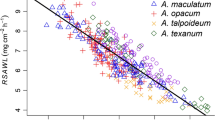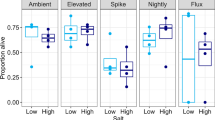Abstract
Assessing carryover effects from the aquatic to the terrestrial stage of pond-breeding amphibians is critical as temperature and hydrologic regimes of temporary ponds continue to be altered as a result of climate change and other stressors. We evaluated carryover effects of hydroperiod length (50–62 days) on amphibian survival, developmental rates, and locomotor performance using a model organism, the wood frog (Rana sylvatica), through aquatic and terrestrial mesocosm experiments with individual tests of locomotor performance. We found that shorter hydroperiods (50 days) had low larval survival (0.44 ± 0.03) compared to the 62-day hydroperiod (0.91 ± 0.09) and increased developmental rates, resulting in smaller sizes at metamorphosis. We did not find evidence of carryover effects on terrestrial survival three months post-metamorphosis with all hydroperiod treatments showing high terrestrial survival (0.88 ± 0.07). However, post-metamorphic frogs from the longer hydroperiod treatments grew faster and larger compared to individuals from shortest hydroperiods and performed significantly better during endurance trials at 18 °C. Disentangling complex carryover effects across multiple life stages in species with high phenotypic plasticity can shed light on the physiological capacity of species to respond to changing environments and inform mechanistic predictions of persistence in the face of anthropogenic stressors.




Similar content being viewed by others
References
Alton LA, Franklin CE (2017) Drivers of amphibian declines: effects of ultraviolet radiation and interactions with other environmental factors. Clim Chang Responses 4:6. https://doi.org/10.1186/s40665-017-0034-7
Baldwin RF, Calhoun AJK, DeMaynadier PG (2006a) The significance of hydroperiod and stand maturity for pool-breeding amphibians in forested landscapes. Can J Zool 84:1604–1615. https://doi.org/10.1139/Z06-146
Baldwin RF, Calhoun AJK, Maynadier PG (2006b) The significance of hydroperiod and stand maturity for pool-breeding amphibians in forested landscapes. Can J Zool 84:1604–1615. https://doi.org/10.1139/Z06-146
Beck CW, Condgon JD (1999) Effects of individual variation in age and size at metamorphosis on growth and survivorship of southern toad (Bufo terrestris) metamorphs. Can J Zool 77:944. https://doi.org/10.1139/z99-041
Beck CW, Congdon JD (2000) Effects of age and size at metamorphosis on performance and metabolic rates of Southern Toad, Bufo terrestris, metamorphs. Funct Ecol 14:32–38. https://doi.org/10.1046/j.1365-2435.2000.00386.x
Berven KA (1988) Factors affecting variation in reproductive traits within a population of wood frogs (Rana sylvatica). Copeia. https://doi.org/10.2307/1445378
Berven KA, Berven KA (1990) Factors affecting population fluctuations in larval and adult stages of the wood frog (Rana sylvatica). Ecology 71:1599–1608. https://doi.org/10.2307/1938295
Berven KA, Grudzien TA (1990) Dispersal in the wood frog (Rana sylvatica): implications for genetic population-structure. Evolution (NY) 44:2047–2056
Boes MW, Benard MF (2013) Carry-over effects in nature: effects of canopy cover and individual pond on size, shape, and locomotor performance of metamorphosing wood frogs. Copeia 2013:717–722. https://doi.org/10.1643/CE-12-091
Boone MD (2005) Juvenile frogs compensate for small metamorph size with terrestrial growth: overcoming the effects of larval density and insecticide exposure. J Herpetol 39:416–423. https://doi.org/10.1670/187-04A.1
Brady LD, Grif RA (2000) Developmental responses to pond desiccation in tadpoles of the British anuran amphibians (Bufo bufo, B. calamita and Rana temporaria). J Zool 25:61–69
Catenazzi A (2015) State of the World’s amphibians. In: Stuart SN, Hoffmann M, Chanson JS et al (eds) Ssrn. IUCN Conservation International and NatureServe, Barcelona, pp 33–44
Chelgren ND, Rosenberg DK, Heppell SS, Gitelman AI (2006) Carryover aquatic effects on survival of metamorphic frogs during pond emigration. Ecol Appl 16:250–261. https://doi.org/10.1890/04-0329
Cline BB, Hunter ML (2014) Different open-canopy vegetation types affect matrix permeability for a dispersing forest amphibian. J Appl Ecol 51:319–329. https://doi.org/10.1111/1365-2664.12197
Cooper EB, Kruuk LEB (2018) Ageing with a silver-spoon: a meta-analysis of the effect of developmental environment on senescence. Evol Lett 2:460–471. https://doi.org/10.1002/evl3.79
Davenport JM, Hossack BR, Fishback L (2016) Additive impacts of experimental climate change increase risk to an ectotherm at the Arctic’s edge. Glob Chang Biol 23:1–10. https://doi.org/10.1111/gcb.13543
Davis SJ, Caldeira K, Matthews HD (2010) Future CO2 emissions and climate change from existing energy infrastructure. Science 329(5997):1330–1333
Dunn OJ (1964) Multiple comparisons using rank sums. Technometrics 6:241–252. https://doi.org/10.1080/00401706.1964.10490181
Earl JE, Semlitsch RD (2013) Carryover effects in amphibians: are characteristics of the larval habitat needed to predict juvenile survival? Ecol Appl 23:1429–1442. https://doi.org/10.1890/12-1235.1
Earl JE, Whiteman HH (2015) Are commonly used fitness predictors accurate? A meta-analysis of amphibian size and age at metamorphosis. Copeia 103:297–309. https://doi.org/10.1643/CH-14-128
Fitzpatrick MJ, Porter WP, Pauli JN et al (2020) Future winters present a complex energetic landscape of decreased costs and reduced risk for a freeze-tolerant amphibian, the Wood Frog (Lithobates sylvaticus). Glob Chang Biol 26:6350–6362. https://doi.org/10.1111/gcb.15321
Gervasi SS, Foufopoulos J (2008) Costs of plasticity: responses to desiccation decrease post-metamorphic immune function in a pond-breeding amphibian. Funct Ecol. https://doi.org/10.1111/j.1365-2435.2007.01340.x
Goater CP (1994) Growth and survival of postmetamorphic toads: interactions among larval history, density, and parasitism. Ecology 75:2264–2274. https://doi.org/10.2307/1940882
Gosner KL (1960) A simplified table for staging anuran embryos and larvae with notes on identification. Herpetologica 16:183–190. https://doi.org/10.2307/3890061
Harper EB, Semlitsch RD (2007) Density dependence in the terrestrial life history stage of two anurans. Oecologia. https://doi.org/10.1007/s00442-007-0796-x
Hector KL, Bishop PJ, Nakagawa S (2012) Consequences of compensatory growth in an amphibian. J Zool 286:93–101. https://doi.org/10.1111/j.1469-7998.2011.00850.x
Hof C, Araujo MB, Jetz W, Rahbek C (2011) Additive threats from pathogens, climate and land-use change for global amphibian diversity. Nature 480:516-U137. https://doi.org/10.1038/nature10650
Holm-Hansen O, Riemann B (1978) Chlorophyll a determination: improvements in methodology. Oikos 30:438. https://doi.org/10.2307/3543338
Laake J (2017) R code for Mark analysis. 1–211
Lambert MR, Smylie MS, Roman AJ et al (2018) Sexual and somatic development of wood frog tadpoles along a thermal gradient. J Exp Zool Part A Ecol Integr Physiol 329:72–79. https://doi.org/10.1002/jez.2172
Le Roux PC, McGeoch MA (2008) Rapid range expansion and community reorganization in response to warming. Glob Chang Biol 14:2950–2962. https://doi.org/10.1111/j.1365-2486.2008.01687.x
Lebreton AJ, Burnham KP, Clobert J, David R (2013) Modeling survival and testing biological hypotheses using marked animals: a unified approach with case studies. Ecol Soc Am 62:67–118. https://doi.org/10.2307/2937171
Lenth RV (2017) Using lsmeans. J Stat Softw 69:1–33
Moore FBG, Gatten RE (1989) Locomotor performance of hydrated, dehydrated, and osmotically stressed anuran amphibians. Hereptologica 45:101–110
O’Regan SM, Palen WJ, Anderson SC (2014) Climate warming mediates negative impacts of rapid pond drying for three amphibian species. Ecology 95:845–855. https://doi.org/10.1890/13-0916.1
Orizaola G, Dahl E, Laurila A (2014) Compensatory growth strategies are affected by the strength of environmental time constraints in anuran larvae. Oecologia 174:131–137. https://doi.org/10.1007/s00442-013-2754-0
Patrick DA, Hunter ML, Calhoun AJK (2006) Effects of experimental forestry treatments on a Maine amphibian community. For Ecol Manag 234:323–332. https://doi.org/10.1016/j.foreco.2006.07.015
Patrick DA, Harper EB, Hunter ML, Calhoun AJK (2008) Terrestrial habitat selection and strong density-dependent mortality in recently metamorphosed amphibians. Ecology 89:2563–2574
Pechenik JA (2006) Larval experience and latent effects—metamorphosis is not a new beginning. Integr Comp Biol 46:323–333. https://doi.org/10.1093/icb/icj028
Pinheiro J, Bates D, DebRoy S, Sarkar D, Heisterkamp S, Van Willigen B, Maintainer R (2017) Package ‘nlme’. Linear and nonlinear mixed effects models, version 3:1
Popescu VD, Hunter ML (2011) Clear-cutting affects habitat connectivity for a forest amphibian by decreasing permeability to juvenile movements. Ecol Appl 21:1283–1295. https://doi.org/10.1890/10-0658.1
Popescu VD, Brodie BS, Hunter ML, Zydlewski JD (2012) Use of olfactory cues by newly metamorphosed wood frogs (Lithobates sylvaticus) during emigration. Copeia 2012:424–431. https://doi.org/10.1643/CE-11-062
R Core Team (2017) R: a language and environment for statistical computing
Raffel TR, Romansic JM, Halstead NT et al (2013) Disease and thermal acclimation in a more variable and unpredictable climate. Nat Clim Chang 3:146–151. https://doi.org/10.1038/nclimate1659
Riha VF, Berven KA (1991) An analysis of latitudinal variation in the larval development of the wood frog (Rana sylvatica). Copeia 1991:209–221
Ruthsatz K, Peck MA, Dausmann KH et al (2018) Patterns of temperature induced developmental plasticity in anuran larvae. J Therm Biol 74:123–132. https://doi.org/10.1016/J.JTHERBIO.2018.03.005
Searcy CA, Gilbert B, Krkošek M et al (2018) Positive correlation between dispersal and body size in green frogs (Rana clamitans) naturally colonizing an experimental landscape. Can J Zool 96:1378–1384. https://doi.org/10.1139/cjz-2018-0069
Semlitsch RD, Bodie JR (2003) Biological criteria for buffer zones around wetlands and riparian habitats for amphibians and reptiles. Conserv Biol 17:1219–1228
Semlitsch RD, Scott DE, Pechmann HK (1988) Time and size at metamorphosis related to adult fitness in Ambystoma talpoideum. Ecology 69:184–192. https://doi.org/10.2307/1943173
Semlitsch RD, Todd BD, Blomquist SM et al (2009) Effects of timber harvest on amphibian populations: understanding mechanisms from forest experiments. Bioscience 59:853–862. https://doi.org/10.1525/bio.2009.59.10.7
Sheth SN, Angert AL (2018) Demographic compensation does not rescue populations at a trailing range edge. Proc Natl Acad Sci USA 115:2413–2418. https://doi.org/10.1073/pnas.1715899115
Sinervo B, Méndez-de-la-Cruz F, Miles DB et al (2010) Erosion of lizard diversity by climate change and altered thermal niches. Science (80-) 328:894–899. https://doi.org/10.1126/science.1184695
Tracy CR, Betts G, Richard Tracy C, Christian KA (2007) Plaster models to measure operative temperature and evaporative water loss of amphibians. J Herpetol 41:597–603. https://doi.org/10.1670/07-006.1
Werner EE, Relyea RA, Yurewicz KL et al (2009) Comparative landscape dynamics of two anuran species: climate-driven interaction of local and regional processes. Ecol Monogr 79:503–521. https://doi.org/10.1890/08-1047.1
White GC, Burnham KP (1999) Program MARK: survival estimation from populations of marked animals. Bird Study 46:S120–S139. https://doi.org/10.1080/00063659909477239
Wilbur HM (1980) Complex life cycles. Annu Rev Ecol Syst 11:67–93. https://doi.org/10.1146/annurev.es.11.110180.000435
Acknowledgments
This research was funded by the National Science Foundation – Graduate Research Fellowship Program (NSF-GRFP; under Grant No. 11086-18.03-1116139) to Cassandra Thompson, the Department of Biological Sciences at Ohio University, and the Ohio University Graduate Student Senate. Any opinions, findings, and conclusions or recommendations expressed in this material are those of the author(s) and do not necessarily reflect the views of the National Science Foundation. The aquatic mesocosm setup benefited from an Ohio University 1804 Fund grant awarded to Viorel Popescu. We thank Roxanne Male-Brune and Carl Brune for help with securing wood frog egg masses, Mike Benard for helpful comments on a previous draft of this manuscript, Steve Reilly and Don Miles for helpful advice on designing experiments, and Michael McAvoy for help with identifying a suitable location for aquatic mesocosm facility. We also thank Devon Cottrill, Heidi Bencin, Marcel Weigand, Nick Jordan, Ryan Brown for field assistance and help with data collection, and Ohio University Biological Sciences graduate students for help with terrestrial pen construction. This work was performed under Ohio University IACUC protocol 16-L-027.
Author information
Authors and Affiliations
Contributions
CMT and VDP conceived and designed the experiments. CMT performed the experiments. CMT and VDP analyzed the data. CMT and VDP wrote the manuscript.
Corresponding author
Additional information
Communicated by Howard Whiteman.
Our study highlights important tradeoffs of aquatic-to-terrestrial carryover effects on the growth, survival, and performance of larval and terrestrial stages of a pond-breeding anuran, the wood frog.
Supplementary Information
Below is the link to the electronic supplementary material.
Rights and permissions
About this article
Cite this article
Thompson, C.M., Popescu, V.D. Complex hydroperiod induced carryover responses for survival, growth, and endurance of a pond-breeding amphibian. Oecologia 195, 1071–1081 (2021). https://doi.org/10.1007/s00442-021-04881-3
Received:
Accepted:
Published:
Issue Date:
DOI: https://doi.org/10.1007/s00442-021-04881-3




